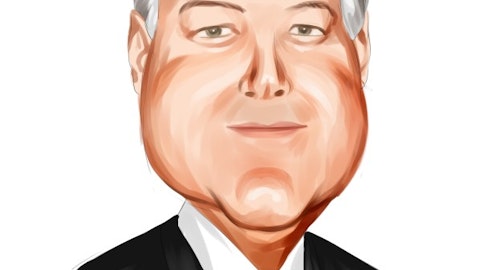Research In Motion Limited (NASDAQ:RIMM) was up big last week – as much as 15% – on news that the U.S. government is pulling plans to purchase Apple’s iPhones, instead opting to support Research In Motion’s Blackberry devices. One headwind, despite the Canadian-based phone maker’s plans to woo government agencies and corporations with robust security features provided by its Blackberry 10, is that many private users may opt not to incur switching costs to follow suit. In terms of aggregate capital invested, hedge fund interest in RIM increased by 32% last quarter, but notable billionaire Ken Griffin sold off over 80% of his Research In Motion stake (check out Ken Griffin’s newest picks).
Research In Motion’s most recent quarter was better than expected, on the back of added subscribers and a bolstering cash position. In conjunction with its latest earnings announcement, management reiterated expectations that Blackberry 10 phones would be ready for market in 1Q 2013. A sustained turnaround effort will continue to take time, and the results from the Blackberry 10 release will remain unknown until at least the Spring. Additionally, product mix remains a concern as the phone maker continues to push its low-end Blackberry phones until Blackberry 10 devices come to market. These lower-end phones are causing margin compression, a phenomenon that isn’t aided by increased competition from low-cost phone manufacturers in China.
Meanwhile, Qualcomm, Inc. (NASDAQ:QCOM) is a key company in the wireless industry, providing integral telecommunications products used in a variety of mobile phones. Compared to other notable semiconductor company Texas Instruments, Qualcomm trades in line on a P/E basis at 20x, but its forward P/E of only 13x might give investors a value opportunity. Unlike many other tech companies, Qualcomm does pay a reasonable dividend that yields 1.6%. Billionaire Ken Fisher – founder of Fisher Asset Management and long-time Forbes columnist – is one of Qualcomm’s top shareholders (see Ken Fisher’s new picks).
Harris Corporation (NYSE:HRS) is another com-equipment company that appears to offer investors a value at the moment. Harris’ forward P/E (10x) puts it below other major peers and its 3% dividend yield is only a 25% payout of earnings. Harris is also refocusing on its core communications segment and higher growth opportunities, such as RF tags, after selling off its broadcasting segment to Gores Group. Harris had big-time billionaire Steve Cohen of SAC Capital taking a new position in the company last quarter (see Steven Cohen’s top picks).
We can’t discuss RIM and the rest of this industry without mentioning Google Inc (NASDAQ:GOOG), the maker of the market-leading Android operating system. The search giant saw weakness earlier this year on a 3Q earnings miss of 15%, but has since recovered on renewed optimism concerning its mobile advertising potential. Additionally, a diverse product portfolio should help Google counter the weakness in its recently-acquired Motorola Mobility brand. Google is one of the top ten stocks loved by hedge funds, and has a host of billionaires as investors including Ken Griffin, Ken Fisher and Jim Simons (check out Jim Simons’ top bets).
Nokia Corporation (NYSE:NOK) is a fellow phone maker that has seen a steady decline in stock price and market share since the end of 2007. This selloff is in part due to a weak economy, but may be equally a result of market share “attacks” from the likes of Google and Apple. Nokia boosts a market cap double that of Research In Motion at $14 billion, but also has managed to keep paying its dividend. Now, Nokia has cut its payout in each of the last four quarters, but still pays a robust 6% yield. Billionaire D.E. Shaw fell out of love with Nokia last quarter, and sold off over 75% of his stake (check out D.E. Shaw’s latest moves).
From a valuation standpoint, Research In Motion and Nokia’s poor outlooks put earnings expectations in the red for the foreseeable future, at least until we can see the full effects of the latter’s Blackberry 10 model. On a P/S basis, Nokia remains cheaper (0.35x) than Research In Motion (0.46x), and well below communications company Harris (1.0x).
Any “buy” recommendation for Research In Motion remains uncertain at best, as user-friendly Android and iOS devices continue their onslaught of smartphone market share. This uncertainty puts Research In Motion’s three-year expected earnings growth rate at -12%, where the other communications peers listed here – Harris, Google and Qualcomm – all have 30%+ growth rates.
Even while taking a longer term focus, we remain unconvinced regarding Research In Motion’s ability to execute a turnaround. We look at Nokia’s long-term results following its slide from being a mobile titan, and worry Research In Motion may be caught in a similar trading range indefinitely. Interestingly, Research In Motion may also be a takeover target in the sights of several notable hedge funds (see all five here), so there is some hope on the horizon.






